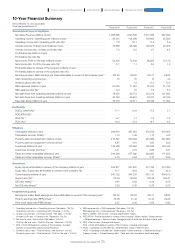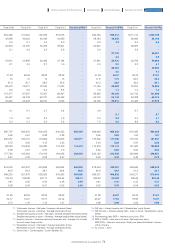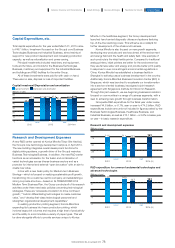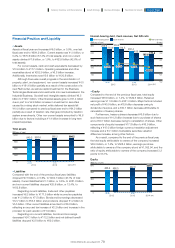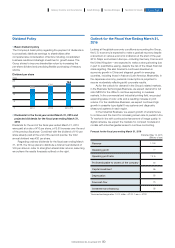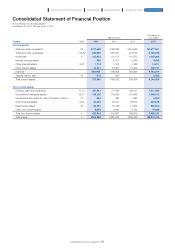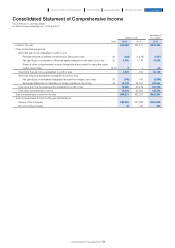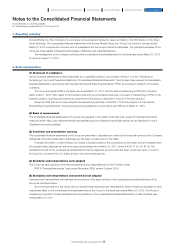Konica Minolta 2015 Annual Report Download - page 79
Download and view the complete annual report
Please find page 79 of the 2015 Konica Minolta annual report below. You can navigate through the pages in the report by either clicking on the pages listed below, or by using the keyword search tool below to find specific information within the annual report.
Capital Expenditure, etc.
Research and Development Expenses
A new R&D center opened at Konica Minolta Tokyo Site Hachioji,
the Group’s core technology development campus, in April 2014.
The new building integrates overall development functions for
digital printing systems, a growth driver of the Group’s mainstay
Business Technologies Business. In addition, the new R&D center
functions as an accelerator for the fusion and combination of
varied technologies across diverse business sectors and as a
promoter for internal and external “open innovation” with an aim to
create new value.
In line with a new basic policy for Medium-term Business
Strategy—which is focused on realizing sustainable profit growth,
transforming into a customer-centric company, and establishing a
strong corporate structure—based on its TRANSFORM 2016
Medium Term Business Plan, the Group conducts all of its research
activities under three new basic policies concerning technological
strategies. These are “accelerate incubation to drive continued
growth,” “build in differentiating technologies to create customer
value,” and “develop first-class technological personnel and
strengthen organizational development capabilities.”
In existing production printing segment, Konica Minolta is
expanding its business into heavy production printing, which
involves large print volumes and requires a high level of productivity
and the ability to accommodate a variety of paper types. This will
be done alongside efforts to provide services unique to Konica
Total capital expenditure for the year ended March 31, 2015 came
to ¥46.1 billion. Investment focused on the Group’s core Business
Technologies Business and Industrial Business, aimed mainly at
support for new product development and increasing production
capacity, as well as rationalization and power saving.
Principal investments included machinery and equipment,
tools and furniture, and molds for the Business Technologies
Business, machinery and equipment for the Industrial Business,
and buildings and R&D facilities for the entire Group.
All of these investments were paid for with cash on hand.
There was no sale, disposal or loss of important facilities.
60
50
40
30
20
10
0
(Billions of yen)
46.1
Capital investment Depreciation and amortization
20132012 2014 (FY)
J-GAAP IFRS
38.4
45.9 47.3 47.3 47.4 43.8 47.9
Minolta. In the healthcare segment, the Group developed and
launched hand-carried diagnostic ultrasound systems featuring
top-of-the-line resolving power. This will serve as a catalyst for
further development of the ultrasound business.
Konica Minolta is also focused on new growth segments,
developing new products and services aimed at the environment
and energy field and the health and safety field. One example of
such products is the inkjet textile printer. Compared to traditional
analog printers, inkjet printers are better for the environment as
they use far less water and energy and provide better print quality.
In response to ever more stringent environmental regulations in
China, Konica Minolta has established a business facility in
Shanghai to actively pursue business development in the country.
Additionally, Konica Minolta’s Business Innovation Center (BIC) in
Singapore, which was launched to accelerate our transformation
into a service-oriented business, has signed a joint research
agreement with Singapore’s Institute for Infocomm Research.
Through this joint research, we are beginning business incubation
focused on communities in a range of business segments, with a
view to achieving new growth through business transformation.
Groupwide R&D expenditure for the fiscal year under review
increased ¥4.6 billion, or 6.7%, year on year to ¥74.2 billion. R&D
expenditures include amounts not included in figures posted by the
Business Technologies Business, Healthcare Business, and
Industrial Business, as well as ¥13.1 billion—a 2.6% increase year
on year—in basic research expenditure.
100
75
50
25
0
(Billions of yen)
74.2
20132012 2014 (FY)
J-GAAP IFRS
71.5 71.1 69.5
Research and development expenses
16
12
8
4
0
14.0 12.7 13.1
20132012 2014
(FY)
J-GAAP IFRS
14.6
(Billions of yen)
R&D expenditure for common fundamental technologies and
advanced technologies
Capital investment/Depreciation and amortization
78
KONICA MINOLTA, INC. Annual Report 2015
Foundation for GrowthBusiness StrategiesGrowth StrategyCompany Overview and Characteristics Financial Report







